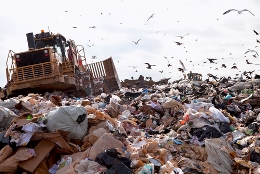08 September 2016
 A whole new way of thinking will be required if we are to escape the weight of a global urban waste problem estimated at between 7 and 10 billion tonnes annually and set to double in the next 20 years.
A whole new way of thinking will be required if we are to escape the weight of a global urban waste problem estimated at between 7 and 10 billion tonnes annually and set to double in the next 20 years.
In an important one-day symposium today, The Futures of Waste, UniSA’s School of Art, Architecture and Design and the Hawke Centre will confront, in pictures and words, the issue of burgeoning waste production in the linear economy and look at the latest theories on how waste can be reduced, reused and recycled emphasising local, rather than global actions.
Symposium organiser and Deputy Director of the China Australia Centre for Sustainable Urban Development Dr Robert Crocker says The Future of Waste will explore both negative and positive take-home messages.
“While we can’t continue producing so much waste without adding to our environmental problems and global greenhouse gas emissions, there are ways of dealing with waste, including changing how we design, make and use our goods, how we dispose of them, and what we do with waste,” Dr Crocker says.
“This seminar, keynote address and related photographic exhibition draws attention to both the larger problems and their potential solutions.”
The seminar includes brief presentations on the economics, social impacts, design and technology issues associated with the ‘waste problem’ but also potential solutions.
Two important contributions to the Symposium include a special one-on-one digital interview filmed in Geneva with the pioneer of the circular economy, Professor Walter Stahel and UniSA’s Assoc Prof David Ness, followed by a panel discussion, and also presentations from UniSA’s Tianjin University partners in the China Australia Centre for Sustainable Urban Development, led by Professor Guanyi Chen.
Keynote speaker at the symposium Professor of Materials Science from the University of New South Wales, Veena Sahajwalla, will explore how current methods of recycling waste into similar items, of a lesser value, needs to be re-imagined.
She will argue that far greater environmental and economic impacts can be achieved by “greening” the industrial processes that deliver the materials, components and products that mass, global markets demand - potentially reducing the environmental footprint of everything around us.
Prof Sahajwalla believes energy, raw materials, resources and manufacturing inputs may be able to be derived from waste by “mining” the world’s landfills for materials such as carbon, hydrogen, silica, titania and a host of metals, delivering savings economically and environmentally.
The symposium also includes the launch of Futures of Waste: Photographic Perspectives an exhibition of photographs looking at the impacts of waste but also the potential for solutions to the waste problem in UniSA’s Kerry Packer Civic Gallery. It includes work from award-winning international photographers, Renée C Byer and Chris Jordan, and covers all scales and regions, from photographs of plankton ingesting micro-plastics, dead baby seabirds fed plastics by their mothers on remote Pacific islands, to large scale dumps and recycling enterprises in India and Indonesia.
It includes a fascinating insight into the many millions of poor people employed to ‘deal with’ our wastes around the world. The Exhibition was opened by Mr Vaughan Levitzke, PSM, CE of Green Industries SA.
Media contact: Michèle Nardelli mobile: +61 418 823 673 email: michele.nardelli@unisa.edu.au
For further details and interviews contact: Dr Robert Crocker, 83020206 or by email, Robert.Crocker@unisa.edu.au.




